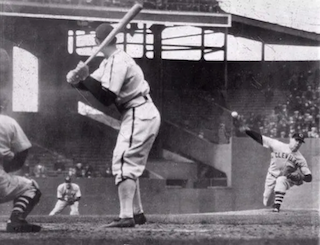
Bob Feller of the Cleveland Indians fires up a no-hitter against the Chicago White Sox at Comiskey park on Opening Day, April 16, 1940. Photo by Mark Rucker/Transcendental Graphics, Getty Images
March/April 2024 (Volume 16, Issue 2)
By Michael Swanger
Of the thousands of Opening Day games played in Major League Baseball, Hall of Fame pitcher and Van Meter native Bob Feller holds the historic distinction of having thrown the first Opening Day no-hitter. And like so many no-hitters in MLB history, it featured a great deal of skill, a little luck and a defensive gem before it could be entered into baseball’s record books.
The historic feat occurred on April 16, 1940, when Feller’s visiting Cleveland Indians (now known as the Guardians) defeated the hometown Chicago White Sox, 1-0, on a blustery 40-degree day in front of about 14,000 half-frozen fans at Comiskey Park on Chicago’s South Side. Among those in attendance were Feller’s parents, William and Lena Feller, and his sister, Marguerite Feller, all of whom had traveled from Iowa to watch “The Heater From Van Meter” take the mound to start the 1940 season. So, too, was MLB Commissioner Judge Kenesaw Mountain Landis and American League President Will Harridge.
The 21-year-old Feller, whom Des Moines Register Sports Editor Sec Taylor described that day as “all seven wonders of the baseball pitching world combined” in his report of the game for the newspaper, was already a star pitcher in the major leagues who was breaking records. Still, no one could have predicted the gem that “Bullet Bob” was about to toss that day in spite of the high expectations heaped upon the young pitcher.
A prodigy who made his debut with the Indians at age 17 in 1936 — the summer before his senior year at Van Meter High School — Feller went 5-3 during his record-setting rookie year in which baseball writer Richard Goldstein deemed Feller, “the best-known young person in America, with the possible exception of Shirley Temple.”
Fellow Iowan Cy Slapnicka, a scout for the Indians, who signed Feller for $1 and an autographed baseball in 1936, said of the young hurler in “The Cleveland Indians Encyclopedia,” “I knew he was something special. His fastball was fast and fuzzy; it didn’t go in a straight line; it would wiggle and shoot around. I didn’t know then that he was smart and had the heart of a lion, but I knew that I was looking at an arm the likes of which you see only once in a lifetime.”
In 1937, Feller appeared on the cover of the April 19th issue of Time magazine, but spent the opening months on the bench after injuring his elbow. He would finish the season with a record of 9-7.
In 1938, recovered from his injury, Feller hurled 20 complete games and compiled a record of 17-11 for Cleveland.
The following season, 1939, was the start of a string of three incredibly successful campaigns for Feller in which he went 24-9 with a 2.85 ERA, 27-11 and 25-13, respectively. Feller was in the prime of his career but it was about to be interrupted.
On Dec. 9, 1941, two days after the Japanese attack at Pearl Harbor, Feller became the first famous athlete to answer the call of duty and enlist in the U.S. Navy to serve his country during World War II. For the next four years the Iowan served as Gun Captain aboard the USS Alabama. He would not return to the baseball until after the war in 1945. (Read Iowa History Journal’s November/December 2016 story “Act of Valor” to learn more about Feller’s military service.)
TO READ THE ENTIRE STORY AND OTHER FASCINATING STORIES ABOUT IOWA HISTORY, subscribe to Iowa History Journal.
